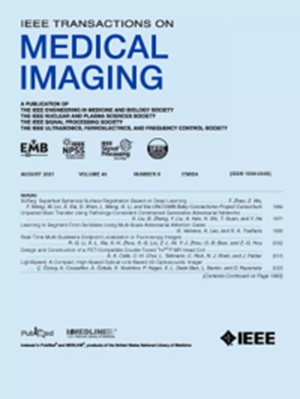病变不对称筛查辅助全局感知多视图网络进行乳腺x线照片分类。
IF 9.8
1区 医学
Q1 COMPUTER SCIENCE, INTERDISCIPLINARY APPLICATIONS
引用次数: 0
摘要
乳房x光检查是早期筛查的主要方法,开发基于深度学习的计算机辅助系统具有重要意义。然而,目前的深度学习模型通常将每个图像视为一个独立的实体进行诊断,而不是将来自多个视图的图像集成来诊断患者。这些方法没有充分考虑和处理不同视图之间复杂的相互作用,导致诊断性能和可解释性较差。为了解决这一问题,本文提出了一种新的端到端乳腺癌诊断框架:病变不对称筛查辅助全局感知多视图网络(LAS-GAM)。LAS-GAM不仅仅是最常见的图像级诊断模型,它还可以在患者层面运行,模拟放射科医生分析乳房x线摄影图像的工作流程。该框架处理患者的四个视图,并围绕两个关键模块:全局模块和病变筛查模块。全局模块模拟放射科医生的综合评估,整合来自双乳颅侧(CC)和中外侧斜(MLO)视图的互补信息,生成代表患者整体状况的全局特征。病变筛选模块通过比较对侧视图的对称区域,识别潜在病变区域,并使用轻量级模型提取病变特异性特征,模拟病变定位过程。通过结合全局特征和病变特异性特征,LAS-GAM模拟诊断过程,做出患者级别的预测。此外,它只使用患者级别的标签进行训练,大大降低了数据注释成本。在乳腺筛查数字数据库(DDSM)和内部数据集上的实验验证了LAS-GAM, auc分别为0.817和0.894。本文章由计算机程序翻译,如有差异,请以英文原文为准。
Lesion Asymmetry Screening Assisted Global Awareness Multi-view Network for Mammogram Classification.
Mammography is a primary method for early screening, and developing deep learning-based computer-aided systems is of great significance. However, current deep learning models typically treat each image as an independent entity for diagnosis, rather than integrating images from multiple views to diagnose the patient. These methods do not fully consider and address the complex interactions between different views, resulting in poor diagnostic performance and interpretability. To address this issue, this paper proposes a novel end-to-end framework for breast cancer diagnosis: lesion asymmetry screening assisted global awareness multi-view network (LAS-GAM). More than just the most common image-level diagnostic model, LAS-GAM operates at the patient level, simulating the workflow of radiologists analyzing mammographic images. The framework processes the four views of a patient and revolves around two key modules: a global module and a lesion screening module. The global module simulates the comprehensive assessment by radiologists, integrating complementary information from the craniocaudal (CC) and mediolateral oblique (MLO) views of both breasts to generate global features that represent the patient's overall condition. The lesion screening module mimics the process of locating lesions by comparing symmetric regions in contralateral views, identifying potential lesion areas and extracting lesion-specific features using a lightweight model. By combining the global features and lesion-specific features, LAS-GAM simulates the diagnostic process, making patient-level predictions. Moreover, it is trained using only patient-level labels, significantly reducing data annotation costs. Experiments on the Digital Database for Screening Mammography (DDSM) and In-house datasets validate LAS-GAM, achieving AUCs of 0.817 and 0.894, respectively.
求助全文
通过发布文献求助,成功后即可免费获取论文全文。
去求助
来源期刊

IEEE Transactions on Medical Imaging
医学-成像科学与照相技术
CiteScore
21.80
自引率
5.70%
发文量
637
审稿时长
5.6 months
期刊介绍:
The IEEE Transactions on Medical Imaging (T-MI) is a journal that welcomes the submission of manuscripts focusing on various aspects of medical imaging. The journal encourages the exploration of body structure, morphology, and function through different imaging techniques, including ultrasound, X-rays, magnetic resonance, radionuclides, microwaves, and optical methods. It also promotes contributions related to cell and molecular imaging, as well as all forms of microscopy.
T-MI publishes original research papers that cover a wide range of topics, including but not limited to novel acquisition techniques, medical image processing and analysis, visualization and performance, pattern recognition, machine learning, and other related methods. The journal particularly encourages highly technical studies that offer new perspectives. By emphasizing the unification of medicine, biology, and imaging, T-MI seeks to bridge the gap between instrumentation, hardware, software, mathematics, physics, biology, and medicine by introducing new analysis methods.
While the journal welcomes strong application papers that describe novel methods, it directs papers that focus solely on important applications using medically adopted or well-established methods without significant innovation in methodology to other journals. T-MI is indexed in Pubmed® and Medline®, which are products of the United States National Library of Medicine.
 求助内容:
求助内容: 应助结果提醒方式:
应助结果提醒方式:


